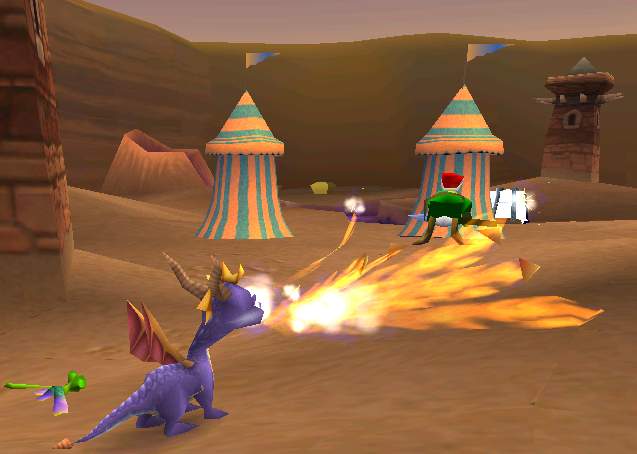I could always count on Spyro to be just one click of a button away in my room, waiting for me to guide him through the next challenge. I was so connected to the game that I started dreaming that I was in his world, helping him along his adventures and guiding the way against the evil Gnorcs. It was a time when my innocent mind allowed me to completely escape from the real world and insert myself into this fantasy that I loved so much.
Spyro made sense. Spyro the Dragon was the first game in which I could connect with the protagonist to the point where I thought of the character as a friend and mentor. No game had ever done that for me before, and my mind was opened up to the fact that a video game could be much more than just a game — it could be a learning experience and picker-upper when things weren’t going well.
When PlayStation started up twenty years ago, the games that were coming out weren’t all that great. You would get stuck on a mission in a game, such as Santa Claus Saves the Earth, but there was never any motivation to fight through the challenge due to poor gameplay and plotlines. Spyro the Dragon, though, changed this.
If you’ve ever heard of PlayStation, chances are that you’ve also heard of Spyro the Dragon. The 1998 Insomniac Games classic was praised for its stunning 3D graphics (for the time) and high replay value. It opened PlayStation up to new possibilities and showed gamers that Sony had the capacity to make a game that was both aesthetically pleasing, relatable and smooth-playing.
The idea of the game is very basic: You play as a young purple dragon named Spyro, who seeks to free the adult dragons from crystal bonds cast by the evil Gnasty Gnorc. You start in the Artisans Homeworld and make your way through each world until you reach Gnasty Gnorc’s world. Each world contains a series of portals that transport you to various levels. But because you don’t need to complete the portal missions in order, you can freely travel in and out of the levels as you choose, giving the game a personal touch. Spyro the Dragon strikes the perfect balance between a strictly chronological story-mode game, such as The Last of Us, and an open-world game, such as Fallout. In a game world that is so open and large, much like Skyrim and Jak and Daxter, the main character must be accompanied by an ally.
Spyro is always followed by his best friend, Sparx the Dragonfly, who acts as his health meter. When you start a new life, Sparx glows a bright golden hue and changes color, and finally disappears, as you are attacked, leaving Spyro completely vulnerable. However, Spyro has some moves up his tail. He can breathe fire, charge with his horns, fly and barrel roll. In my many years of playing, however, I have not once found myself reliant on the barrel roll against enemies, since they are too naive.
From the creepy Clock Fools that inhabit Dream Weavers World to the starving vultures in the Dry Canyon Realm, the enemies fit their respective worlds. They are also completely hellish. So hellish, in fact, that I was scared of a good number of levels in the game as a child. Opponents’ appearances, as well as the way in which they perform their moves, can be daunting.
Slap-Happy Armored Monks from the Dream Weavers World are probably the strangest characters that I’ve ever seen in a video game. These creatures are fat with pencil-like heads, and they have the ability to shift sizes. When they are small, they only let out an eerie screech when you approach them, which, honestly, is almost enough for me to run away from them. In their large form, they wave their arms and scream gibberish, and if you get too close to them, they slap you, not to mention that in their large form, they’re invincible. Enemies like these make up a relatively large portion of the enemies in the game, giving you a scare here and there. Other enemies, such as Green Druids, aren’t quite as terrifying, but they manipulate the environment, forcing you to stop and think about how you can get around them.
Enemies like Clock Fools and Slap-Happy Armored Monks give the game a bit of a learning curve, but they aren’t enough to disprove claims that this game is easy. When I first played this game as a three-year-old, there’s no doubt that I had trouble simply getting Spyro to move the way that I wanted. But when I revisited the game in my teenage years, I found almost no difficulty in getting through the game. Dodging enemies’ hits was no challenge, since most of their moves were so repetitive, and there was a simple formula that worked against each boss. That is the one large downfall of the game. However, defeating each enemy and boss and saving the adult dragons is not, by any means, all there is to do. Each level in the game also contains a certain number of gems, and if you put in the time to collect all of these gems, you can receive 100 percent completion in the game and unlock a secret level.
The gems give you the opportunity to add more play time to the game but do not exactly add to its replay value. The high replay value instead comes from the game’s unique enemies, worlds and soundtrack. Spyro the Dragon’s soundtrack, composed and produced by Stewart Copeland, the former drummer of The Police, is of the progressive-rock genre. Copeland primarily makes use of guitar and drums, creating a unique, upbeat sound for each realm that keeps the game flowing and acts as a counterpart to the gameplay itself. It gives enemies more of their own personality and makes sure that there is never a dull moment, even when you’re just trying to figure out how to jump to a hard-to-reach area.
Thus, we’re left with a truly complete game, and the only negative thing I can say about it is that it is a tad bit too easy, which is fine considering how old the game is and the fact that it was made for children. The amazingly unique characters and landscapes, along with a soundtrack that seamlessly blends into the game, make for a bundle of nostalgia that beckons to you anytime you want to have an enjoyable, stress-free few hours.
And through my completion of the game came a connection with more than just the protagonist. I connected each enemy to a different real-life problem I was experiencing and I connected each dragon I saved to something I solved in the real world. Spyro the Dragon became my escape while also keeping me anchored to the real world. Insomniac Games’ masterpiece will go down in history as containing one of the most relatable, fun-to-play stories of any game during its time.
brian.savino@emory.edu | Brian Savino is a College sophomore from Westchester, New York, majoring in chemistry and minoring in mathematics. He started his Wheel career as the gaming critic for the arts & entertainment section and most recently served as the arts & entertainment editor. When he is not listening to Radiohead, Brian can be found reading about astrochemistry, playing video games or organizing something. To cheer him up, all you need is a Conan Travels video and a chocolate chai from Kaldi’s.







We should play Spyro together sometime Brian!